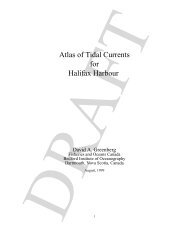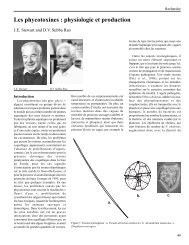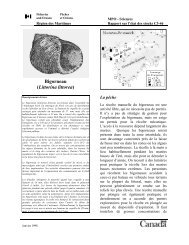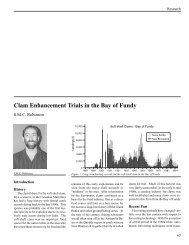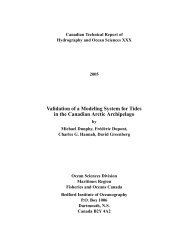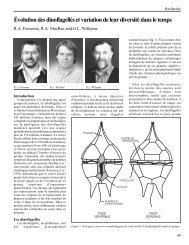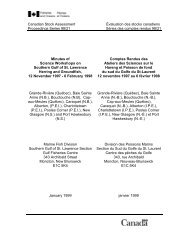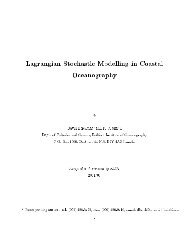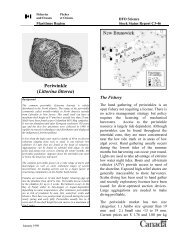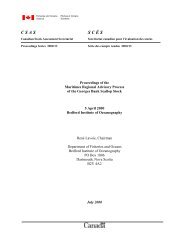bedford institute of oceanography 2001 in review - Région des ...
bedford institute of oceanography 2001 in review - Région des ...
bedford institute of oceanography 2001 in review - Région des ...
Create successful ePaper yourself
Turn your PDF publications into a flip-book with our unique Google optimized e-Paper software.
SCIENCE ACTIVITIES / Mar<strong>in</strong>e Environmental Sciencesassociated with w<strong>in</strong>ds and waves. Wave dissipation takes energy from thespectrum and puts it <strong>in</strong>to surface currents. Dur<strong>in</strong>g a rapidly develop<strong>in</strong>gstorm, surface currents may be enhanced as much as 30-40% by wavedissipation. Dur<strong>in</strong>g quiescent periods when waves are small or are notrapidly develop<strong>in</strong>g, this surface current enhancement effect is small.Thus, waves <strong>in</strong>teract with the atmospheric boundary layer thatforms and drives them. Through wave-<strong>in</strong>duced roughness, sea sprayand other processes, the ocean exchanges mass, momentum, and heatwith the atmosphere. These effects are caused by the mar<strong>in</strong>e w<strong>in</strong>ds,and also have impact on the processes that create and determ<strong>in</strong>e thesew<strong>in</strong>ds. The waves are also coupled to surface currents. These, <strong>in</strong> turn,affect the wave growth. Wave growth leads to wave break<strong>in</strong>g whichadds new momentum to these currents. It is only by work<strong>in</strong>g with acoupled upper ocean and atmospheric boundary layer that one canhope to arrive at an improved understand<strong>in</strong>g <strong>of</strong> mar<strong>in</strong>e storms andtheir impacts on human activities <strong>in</strong> Atlantic Canada.Mar<strong>in</strong>e Environmental SciencesThe Grand Banks Otter Trawl<strong>in</strong>g Experiment– Donald C. Gordon Jr., Kent D. Gilk<strong>in</strong>son, Ellen L.R. Kench<strong>in</strong>gton, Cynthia Bourbonnais,Kev<strong>in</strong> MacIsaac, David L. McKeown, and W. Peter VassMobile fish<strong>in</strong>g gear such as beam trawls, otter trawls, scallop rakes,and clam dredges is widely used around the world to harvest fisheryresources. Concerns have been raised about their environmentaleffects. Understand<strong>in</strong>g the impacts on benthic habitats and communitiesis difficult and expensive, especially for <strong>of</strong>fshore fish<strong>in</strong>g banks.Benthic habitats and communities display considerable natural variability,both spatially and temporally, which must be factored <strong>in</strong>to the<strong>des</strong>ign <strong>of</strong> research programs.Over the past 50 years, otter trawls have been widely used <strong>in</strong>Atlantic Canada to capture bottom dwell<strong>in</strong>g species such as cod,haddock, plaice, flounder, and shrimp. From 1993-1995, weconducted an experiment to exam<strong>in</strong>e the effects <strong>of</strong> <strong>in</strong>tensive ottertrawl<strong>in</strong>g on a sandy bottom ecosystem at a depth <strong>of</strong> 120-146 m on theGrand Banks <strong>of</strong>f Newfoundland. Analysis <strong>of</strong> historical effort data<strong>in</strong>dicated that the study site had not been trawled for at least 13 yearsand was therefore undisturbed. Three, 13 km long experimentalcorridors were trawled twelve times each year, with an Engel 145 ottertrawl equipped with rockhopper footgear. A broad array <strong>of</strong> imag<strong>in</strong>gand sampl<strong>in</strong>g <strong>in</strong>strumentation was used to survey trawled and nearbyreference corridors both before and after experimental trawl<strong>in</strong>g overdifferent spatial scales. This <strong>in</strong>strumentation <strong>in</strong>cluded si<strong>des</strong>can sonar,an epibenthic sled, and a video-equipped grab.Location <strong>of</strong> study site on the Grand Banks and orientation <strong>of</strong> trawled (T) and reference(R) corridors (300 meters apart). All three corridors were trawled while theepibenthic sled and videograb samples were only collected <strong>in</strong> corridors A and B.The most pronounced impacts were the immediate physicaleffects on habitat. Sediment was resuspended by all parts <strong>of</strong> the ottertrawl, furrows and berms were formed by the doors, biological sedimentstructures were either modified or <strong>des</strong>troyed, and organicdetritus was dispersed. However, these physical effects appeared to berelatively short-lived. The available evidence suggested that thehabitat recovered <strong>in</strong> about a year or less.The most immediate biological effect was the removal <strong>of</strong> largeepibenthic organisms from the seabed by the otter trawl. Except forsnow crabs and basket stars, removal appears to have an <strong>in</strong>significanteffect at the population level. This is because <strong>of</strong> the low efficiency <strong>of</strong>the otter trawl <strong>in</strong> catch<strong>in</strong>g epibenthic organisms.Less obvious, but more significant, was the immediate damagedone to epibenthic organisms that were left beh<strong>in</strong>d on the seabed.Some were killed outright, while others were damaged or exposed.Most susceptible were the larger epibenthic organisms that live on thesediment surface such as snow crabs, basket stars, sand dollars, brittlestars, sea urch<strong>in</strong>s, and s<strong>of</strong>t corals. The net effect was a 24% reduction<strong>in</strong> mean biomass, with<strong>in</strong> a few days after trawl<strong>in</strong>g. This reduction <strong>in</strong>biomass was due to removal by the otter trawl, predation by scaveng<strong>in</strong>gorganisms, displacement outside the disturbed area, andperhaps burial by resuspended sediment.Both the immediate and long-term impacts <strong>of</strong> otter trawl<strong>in</strong>g onbenthic <strong>in</strong>fauna, which live with<strong>in</strong> the sandy seabed, appeared to bem<strong>in</strong>or. For the most part, significant effects were seen <strong>in</strong> a limitednumber <strong>of</strong> polychaetes and were restricted to one year <strong>of</strong> the experiment(1994). All available evidence suggested that the biologicalcommunity recovered from the trawl<strong>in</strong>g disturbance <strong>in</strong> less than ayear. Most <strong>of</strong> the affected epibenthic species have some power <strong>of</strong>locomotion, and migration <strong>in</strong>to the disturbed area from thesurround<strong>in</strong>g undisturbed area was highly probable. Effects wereobserved on only 25 species out <strong>of</strong> over 250 taxa, so the majority <strong>of</strong>species present (<strong>in</strong>clud<strong>in</strong>g all the molluscs) were not affected by ottertrawl<strong>in</strong>g. No significant effects could be seen on the benthic communityafter three years <strong>of</strong> trawl<strong>in</strong>g. The habitat and biological communityat the experimental site were naturally dynamic and exhibitedmarked changes irrespective <strong>of</strong> trawl<strong>in</strong>g activity. The effects <strong>of</strong>24 / BIO-<strong>2001</strong> IN REVIEW



